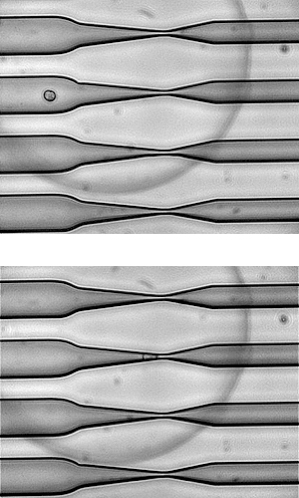Device Squeezes Cells to Get Drugs In
Several potentially transformative treatments for cancer and HIV face a common obstacle—getting drugs into cells, which are designed to reject foreign materials.

A new microfluidic device, recently developed by a startup called SQZ Biotech, can get microscopic material into cells quickly and cheaply by vigorously squeezing those cells, temporarily making their membranes permeable.
Though the technology is only a research tool now, it might be just what’s needed to bring some promising new cancer and HIV therapies to patients. It could be used in a type of treatment that’s just starting to take off, called immunotherapy, which involves modifying a person’s immune cells to effectively target diseases such as cancer (see “The Revival of Cancer Immunotherapy”). Immunotherapy typically requires getting proteins or genetic material into the cells, often by drawing blood and modifying the cells outside of the body, then injecting them back into the patient.
SQZ says it may be able to significantly cut the costs of immunotherapy and improve its effectiveness, factors that have prevented the approach from being commercialized. Just last month, one of the pioneers in immunotherapy, Dendreon, declared bankruptcy after its high-cost treatment failed to sell quickly enough.
“SQZ’s system has shown that it can deliver many materials, such as proteins, small molecules, and RNA, to immune cells more efficiently and with less toxicity than existing technologies,” says Robert Langer, a professor at MIT and an SQZ board member.
Other delivery options for immunotherapy are applying an electric field or using a virus to introduce genetic material into cells, which then triggers the cells to make proteins. But these indirect approaches can be slow and costly. The new device works in seconds and is small enough to be used bedside in hospitals, says SQZ, which was founded in 2013.
To use the device, researchers draw blood from a subject, then extract white blood cells and deposit them into a reservoir in the device along with whatever substance they want to introduce into the cells. A pump forces the blood cells through 75 microscopic channels. Midway through the channel the cells reach a constriction that squeezes them and forces them to stretch out, allowing the substance to be pushed in.
The key to introducing materials is forcing the cells through the constriction fast enough that their ordinary defense mechanisms have no time to react, says Jonathan Gilbert, a former MIT researcher and currently the business development manager of SQZ. That leaves the cell membranes temporarily permeable, allowing proteins and other molecules to enter the cell. Treated cells are then injected back into the subject (typically a mouse, for now).
SQZ’s devices are currently being used by a number of biologists, and the company is in the early stages of testing it for use with experimental treatments. One approach would be to use it to introduce cancer-related proteins into immune cells. Doing this triggers a stronger-than-normal immune response. Researchers have shown that such immune responses can shrink tumors.
Keep Reading
Most Popular
Large language models can do jaw-dropping things. But nobody knows exactly why.
And that's a problem. Figuring it out is one of the biggest scientific puzzles of our time and a crucial step towards controlling more powerful future models.
How scientists traced a mysterious covid case back to six toilets
When wastewater surveillance turns into a hunt for a single infected individual, the ethics get tricky.
The problem with plug-in hybrids? Their drivers.
Plug-in hybrids are often sold as a transition to EVs, but new data from Europe shows we’re still underestimating the emissions they produce.
Stay connected
Get the latest updates from
MIT Technology Review
Discover special offers, top stories, upcoming events, and more.